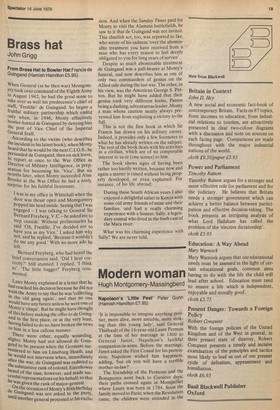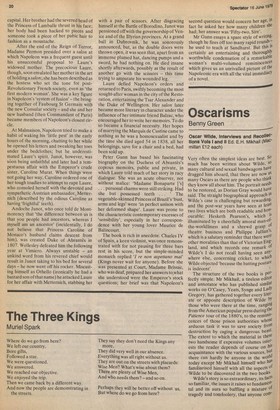Modern woman
Hugh Montgomery-Massingberd
Napoleon's 'Little Pest' Peter Gunn (Hamish Hamilton £7.95) 'It is impossible to imagine anything prettier, more alive, more amiable, more striking than this young lady', said General Thiebault of the 16-year-old Laure Permon at the time of her marriage in 1800 to General Junot, Napoleon's faithful companion-in-arms. Before the marriage, Junot asked the First Consul for his permission; Napoleon wished him happiness, adding, 'but oh you will have a terrible mother-in-law!'
The friendship of the Permons and the Bonapartes went back to Corsican days; their paths crossed again in Montpellier where Laure was born in 1784. Soon the family moved to Paris; when the Revolution came, the children were stranded in the capital. Her brother had the severed head of the Princess of Lamballe thrust in his face; her body had been hacked to pieces and someone took a piece of her pubic hair to fashion as a moustache.
After the end of the Reign of Terror, Madame Permon presided over a salon at which Napoleon was a frequent guest until his unsuccessful proposal to Laure's widowed mother. The precocious Laure, though, soon emulated her mother in the art of holding a salon; she has been described as the hostess who set the tone for postRevolutionary French society, even as 'the first modern woman'. She was a key figure in Napoleon's 'system of fusion' — the bringing together of Faubourg St Germain with the new Consular society — and she and her new husband (then Commandant of Paris) became members of Napoleon's closest circle.
At Malmaison, Napoleon tried to make a habit of waking his 'little pest' in the early hours of the morning, chatting to her while he opened his letters and tweaking her toes under the bedclothes; but he underestimated Laure's spirit. Junot, however, was soon being unfaithful and later had a tempestuous affair with the Emperor's crude sister, Caroline Murat. When things were not going her way, Caroline ordered one of her tough toadies to attempt to rape Laure, who consoled herself with the devoted and sympathetic Austrian ambassador, Metternich (described by the odious Caroline as having 'frightful' teeth).
Andoche Junot, who once told de Montmorency that 'the difference between us is that you people had ancestors, whereas I myself am an ancestor' (incidentally, I do not believe that Princess Caroline of Monaco's husband claims descent from him), was created Duke of Abrantes in 1807. Wellesley defeated him the following year at Vimiero. Always unstable — an unkind word from his revered chief would result in Junot taking to his bed for several days — he now went off his rocker. Miscasting himself as Othello (ironically he had a bastard son of that name) he attacked Laure for her affair with Metternich, stabbing her with a pair of scissors. After disgracing himself at the Battle of Borodino, Junot was pensioned off with the governorship of Venice and of the Illyrian provinces. At a grand ball in Dubrovnik, he was sonorously announced, but, as the double doors were thrown open, it was seen that, apart from an immense plumed hat, dancing pumps and a sword, he had nothing on. He died insane shortly afterwards, possibly as the result of another go with the scissors — this time trying to amputate his wounded leg.
Laure defied Napoleon's orders and returned to Paris, swiftly becoming the most sought-after woman in the city of the Restoration, entertaining the Tsar Alexander and the Duke of Wellington. Her salon later became more literary in character under the influence of her intimate friend Balzac, who encouraged her to write her memoirs. To do so became a financial necessity. Her hopes of marrying the Marquis de Custine came to nothing as he was a homosexualist and by the time she died aged 54 in 1838, all her belongings, save for a chair and a bed, had been sold up.
Peter Gunn has based his fascinating biography on the Duchess of Abrantes's copious memoirs, public and private, in which Laure told much of her story in racy dialogue. She was an acute observer, not without malice: 'Madame Bonaparte ['s] . . . personal charms were still striking. Had she but possessed teeth . . . ' The vegetable-skinned Princess of Brazil's 'bust, arms and legs' were 'in perfect unison with her deformed shape'. Laure was prone to the characteristic contemporary excesses of 'sensibility', especially in her correspondence with her young lover Maurice de Balincourt.
The book is rich in anecdote. Charles IV of Spain, a keen violinist, was once remonstrated with for not pausing for three bars rest in his score, but the simple-minded monarch replied 'I re non aspettano mai' (Kings never wait for anyone). Before she was presented at Court, Madame Brissac, who was deaf, prepared her answers to what she understood were the Emperor's stock questions; her brief was that Napoleon's second question would concern her age, in fact he asked her how many children she had; her answer was 'Fifty-two, Sire'. Mr Gunn essays a spare style of writing, though he fires off too many rapid rounds:. he used to teach at Sandhurst. But this Is certainly an entertaining and thoroughlY worthwhile condensation of a remarkable woman's multi-volumed reminiscences which gives us an unrivalled picture of the Napoleonic era with all the vital immediacy of a novel.



































 Previous page
Previous page